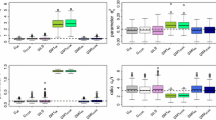Abstract
The probabilistic approach is but one language used by geostatisticians to characterize spatial variability and to express a very simple criterion for goodness of estimation. Notions such as stationarity and ergodicity are important for the consistency of the probabilistic language but are irrelevant to the real problem, that of estimating a well-defined deterministic spatial average. The kriging algorithm is established without any recourse to probabilistic modeling or notation.
Similar content being viewed by others
References
Breiman, L., 1969, Probability and stochastic processes: Houghton Mifflin Co., Boston, 324 p.
Doob, J. L., 1953, Stochastic processes: John Wiley & Sons, New York, 654 p.
Journel, A. G. and Huijbreghts, Ch. J., 1978, Mining geostatistics: Academic Press, London, 600 p.
Matheron, G., 1964, La theorie des variables regionalisees et ses applications: Masson, Paris, 305 p.
Matheron, G., 1978, Estimer et choisir: Les Cahiers du CGMM, Fontainebleau, 175 p.
Omre, H., 1984. The variogram and its estimation:in “Geostatistics for Natural Resources Characterization” ed. Verly et al. publ. Reidel, Dordrecht, Holland, Part I, pp. 107–125.
Author information
Authors and Affiliations
Rights and permissions
About this article
Cite this article
Journel, A.G. The deterministic side of geostatistics. Mathematical Geology 17, 1–15 (1985). https://doi.org/10.1007/BF01030363
Received:
Revised:
Issue Date:
DOI: https://doi.org/10.1007/BF01030363




